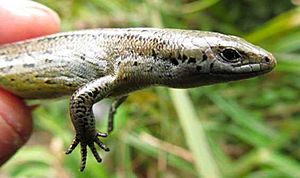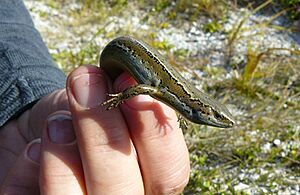Te Kakahu skink facts for kids
Quick facts for kids Te Kakahu skink |
|
|---|---|
 |
|
| Conservation status | |
| Scientific classification | |
| Genus: |
Oligosoma
|
| Species: |
tekakahu
|
| Synonyms | |
|
|
The Te Kakahu skink (Oligosoma tekakahu) is a special kind of skink. It is a small lizard that lives only in New Zealand. This skink is very rare and is in danger of disappearing forever. When it was first found, all the known Te Kakahu skinks lived in one small area. This area was on a cliff top on Chalky Island. Chalky Island is part of Fiordland National Park.
Contents
Discovering the Te Kakahu Skink
How it was Found
The Te Kakahu skink was first discovered in 2002. People from the Department of Conservation (DOC) found it. They were working on a project to help the kakapo bird. In 2008, sixteen skinks were carefully collected. Scientists then studied them. The skink was officially named Oligosoma tekakahu in 2011.
What its Name Means
The skink's name, tekakahu, comes from the Māori name for Chalky Island. The island's full Māori name is Te Kākahu-o-Tamatea. This means "Tamatea's cloak". It refers to an old story. The story says that an explorer named Tamatea dried his cloak on the island. He had gotten wet from the sea. Even though the Māori word for cloak, kākahu, has a special mark called a macron, the skink's name is usually written without it.
What the Te Kakahu Skink Looks Like
The Te Kakahu skink looks a lot like other skinks. These include the cryptic skink (O. inconspicuum) and the southern skink (Oligosoma notosaurus). However, the Te Kakahu skink is different inside its body. It has its own unique genetic makeup.
Body Features
This skink is a bit stronger and has a bigger head. Its body is mostly chestnut brown and looks shiny. It has small black marks on its back. These marks can be tiny dots or a faint line down its middle. There is also a darker stripe along each side of its body. One special thing about this skink is its small ear opening. It has very few scales sticking out from the inside edge of its ear.
Where the Te Kakahu Skink Lives
This skink has only been found in one small place. It lives above windy chalk cliffs on Chalky Island. This spot is about 130 to 140 meters above the sea. People call this area "the blowout". The wind has blown away most of the soil here. Only low plants can grow in this stony place.
Its Special Home
The skinks mostly live in a small patch of low bushes. This area is only about 50 square meters. The plants there are mostly sedges (Carex), Rytidosperma, and small shrubs. These shrubs include Olearia avicennifolia and O. oporina.
Stoats are a type of predator. They were removed from Chalky Island in 1999. So, this small area might have been the only safe place for the skinks. Now, their population might be growing. It is possible that these skinks also live on other nearby islands or the mainland.
Protecting the Te Kakahu Skink
In 2012, the Department of Conservation changed the skink's status. They called it "Nationally Critical". This means it is in very high danger. It got this status because it lives in an area smaller than one hectare. The Te Kakahu skink needs help to survive. Its numbers are partly going down, and it is found in only one place.
Island Safety
Chalky Island has never had rats, mice, possums, or deer. These animals can be harmful to native wildlife. The DOC also removed stoats from the island in 1999. They used traps to do this. Now, the island is free from these harmful animals. The only natural predator for the Te Kakahu skinks is the New Zealand falcon (Falco novaezeelandiae).
These skinks are active during the day. They like to sunbathe for a long time. They also do not seem very scared of new things. However, the single group of skinks is still at risk. If stoats came back or if there was a fire, the whole species could be in danger.
Helping the Skinks Survive
In February 2013, DOC staff counted and studied 160 skinks. They checked their age, sex, and size. A new survey in 2016 showed that there were enough skinks. This meant some could be moved to a new, safe home.
Moving to a New Home
A new release site was chosen on Anchor Island. This island is also free of predators. In February 2018, 99 skinks were moved there. Each skink was photographed. Their unique scale patterns were also recorded. Anchor Island is home to other rare birds. These include the kakapo, little spotted kiwi, and mohua. There are no other skink species on Anchor Island.



